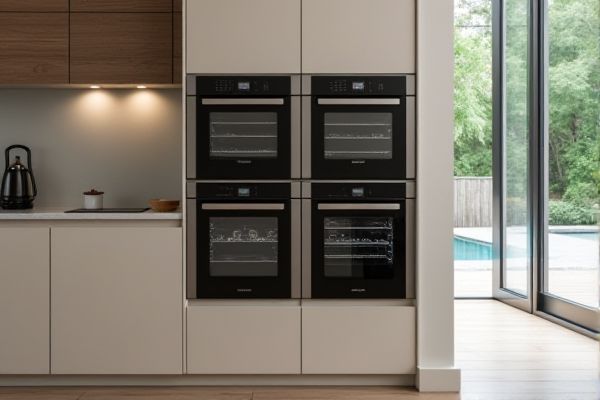
Choosing between a double wall oven and a range depends on your kitchen space and cooking style, with double wall ovens offering more cooking flexibility and ranges combining cooktop and oven functions in one unit. Explore the detailed comparison to find which appliance best suits Your culinary needs and kitchen layout.
Table of Comparison
| Feature | Double Wall Oven | Range |
|---|---|---|
| Structure | Two ovens stacked vertically, built into cabinetry | Oven and cooktop combined in one freestanding unit |
| Cooking Capacity | Higher capacity with two separate ovens | Single oven, generally smaller capacity |
| Space Requirement | Saves floor space, requires wall installation | Requires floor space, freestanding |
| Cooking Flexibility | Cook two dishes at different temperatures simultaneously | Single oven; cooktop offers multiple burners |
| Installation | Built-in, professional installation recommended | Plug and play, minimal installation |
| Cost | Higher upfront cost | More affordable |
| Cleaning | May have self-cleaning but two ovens to maintain | One oven and cooktop cleaning |
| Ideal For | Large families, frequent bakers, and entertainers | Smaller households and general cooking needs |
Introduction to Double Wall Ovens and Ranges
Double wall ovens and ranges are essential kitchen appliances designed for cooking versatility and efficiency. Double wall ovens consist of two separate oven compartments built into the wall, allowing simultaneous baking and roasting at different temperatures. In contrast, ranges combine an oven and cooktop in a single freestanding unit, offering compact convenience with integrated burners and oven space.
Key Differences Between Double Wall Ovens and Ranges
Double wall ovens feature separate upper and lower ovens installed into a wall, providing flexible cooking at different temperatures simultaneously, while ranges combine a cooktop and a single oven in one appliance. Wall ovens typically offer more precise temperature control and save kitchen floor space, whereas ranges provide an integrated cooking surface for stovetop use. The choice depends on kitchen layout preferences, with double wall ovens excelling in multitasking and ranges offering convenient all-in-one functionality.
Space and Installation Considerations
Double wall ovens require built-in wall space and professional installation, making them ideal for kitchens with limited floor area but ample cabinetry. Ranges combine cooktop and oven in one unit, requiring floor space and standard appliance hookups, often simplifying installation and allowing for easier relocation. Choosing between the two depends on kitchen layout, available space, and preferred cooking workflow.
Cooking Capacity and Flexibility
Double wall ovens offer greater cooking capacity by providing two separate oven chambers, allowing you to bake, roast, or broil multiple dishes simultaneously at different temperatures. Ranges combine a cooktop and single oven, which limits your ability to cook large meals or multiple dishes that require distinct heat settings. Your choice depends on whether you prioritize the flexibility of varied cooking methods or the compactness of an integrated unit.
Energy Efficiency Comparison
Double wall ovens generally offer better energy efficiency compared to ranges due to their insulated design and separate cooking compartments that minimize heat loss. Ranges often consume more energy as the oven and cooktop share a single cavity, leading to increased heat transfer and longer preheating times. Energy Star-rated double wall ovens can reduce electricity usage by up to 15% compared to standard ranges, making them a more cost-effective option for frequent baking and roasting.
Design and Aesthetic Appeal
Double wall ovens offer a sleek, built-in design that seamlessly integrates with your kitchen cabinetry, creating a modern and streamlined aesthetic. Ranges, combining a cooktop and oven in one unit, provide a traditional, freestanding look that can become a focal point with stylish finishes and controls. Your choice depends on whether you prefer the minimalist elegance of wall ovens or the classic, functional charm of a range.
Cost and Budget Factors
Double wall ovens typically cost between $1,500 and $3,500, making them more expensive upfront than ranges, which generally range from $700 to $2,500. Installation for double wall ovens often requires professional assistance and can add $200 to $500 to the total expense, while ranges usually have lower or no installation fees. Budget considerations should account for long-term energy efficiency, with double wall ovens potentially offering better multi-cooking options but higher initial investment compared to the more affordable and versatile range units.
Ease of Use and Accessibility
Double wall ovens offer superior ease of use by positioning both ovens at eye level, reducing the need to bend down, which enhances accessibility for users with mobility challenges. Ranges, however, combine cooktop and oven in one appliance, positioned lower to the ground, which may require bending and limit ease of access for some users. Your choice should consider how frequently you need to access the oven safely and comfortably during cooking.
Maintenance and Cleaning
Double wall ovens offer separate compartments that allow you to clean one oven while using the other, making maintenance more convenient. Ranges typically have a single oven underneath the cooktop, which means you clean the entire unit at once, often requiring more effort due to grease and spills from both cooking surfaces. Choosing a double wall oven can simplify your maintenance routine by providing easier access and reducing cross-contamination during cleaning.
Which Is Best for Your Kitchen?
Double wall ovens provide separate cooking compartments allowing simultaneous baking and roasting, ideal for households with diverse meal preparations. Ranges combine an oven and cooktop in a single appliance, saving space and often offering faster preheat times, suitable for smaller kitchens. Choosing the best option depends on kitchen size, cooking habits, and whether flexibility or compactness is a priority.
 homyna.com
homyna.com